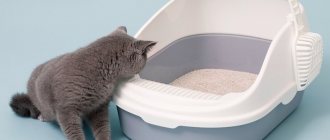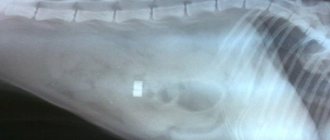What causes bones to get stuck in the throat?
There are several common reasons as a result of which the phraseological phrase “like a bone in the throat” turns into a real dangerous situation:
- Prolonged hunger . If a cat has not received food for a long time, it can literally attack the food, swallowing large pieces without chewing. In this case, there is a high risk that the animal will choke.
- Eating from someone else's bowl . Almost all mustachioed striped animals have a reputation for being very arrogant and unprincipled individuals who are not averse to eating from dog cups. Moreover, particularly shameless individuals may not even allow the owner to approach the bowl until they themselves “taste the dishes.” And if dogs can eat large bones without any problems, then cats may not be able to handle such food.
- Eating a whole fish . Responsible and experienced cat owners know that these pets can only be given boiled fish, previously deboned. But often whole fish, raw, are included in the diet of domestic cats. Not only can such a “delicacy” be infected with helminths, but also sharp fish bones often dig into the delicate mucous membrane of the throat, getting stuck in it or penetrating further into the esophagus and fixing there.
- Picking up street trash. This is a common problem for cats accustomed to free-ranging outside. Here they can eat any, including dangerous, objects that are not always edible.
How to keep your cat safe. The owner should monitor his pet more closely and avoid the presence of:
- duck bones;
- bones of large fish of fatty varieties: silver carp, pike, Siberian roach;
- fish tail bones, heads, as well as gills and gill covers.
If, despite all the preventive measures, a bone still gets stuck in the cat’s throat, then the owner will definitely notice warning signs.
Methods for treating a foreign body in the gastrointestinal tract
The method of choosing treatment depends on the location of the object, its size and material.
There are foreign objects that can come out on their own when symptomatic therapy is prescribed if the bodies are small and intestinal motility is normal.
One of the treatment methods is endoscopic removal of a foreign object from the esophagus or stomach. If the object is small or made of soft material, it can be removed using endoscopic equipment.
Surgical treatment consists of enterotomy or gastrotomy. This is the removal of a foreign body from the stomach or intestines by cutting their wall, followed by removing the object and suturing the walls. Sometimes, due to complications, it is necessary to remove part of the intestine due to its necrosis.
You, dear owners, are of great importance for us, doctors, in the further recovery of patients, because it is you who must notice changes in the pets’ condition in time, contact us and provide post-operative care associated with taking certain medications and certain food.
Keep a close eye on your pets. If you know that he has an unhealthy love for all sorts of inedible things, try to remove them from his reach. If you notice any of the above symptoms, contact the clinic immediately.
Health to you and your pets.
How does a cat behave with a bone in its respiratory tract?
The behavior of a cat caught in such a situation will definitely change. The owner should be alarmed if:
- There is a lack of appetite - if your pet refuses even treats, then perhaps he has a bone stuck in his esophagus.
- There are signs of suffocation, and the cat is breathing frequently and heavily.
- The cat itself makes attempts to get rid of the foreign object, clears its throat, makes appropriate movements and helps itself with its paws.
- Salivation (salivation) increases.
- Exhausting, suffocating spasms of the larynx occur, as with a sore throat.
- The cat is vomiting; there may be a urge to vomit, accompanied by characteristic sounds.
Some cats get scared, begin to avoid people, hide from view and let out a plaintive meow. Prolonged restlessness of a pet is an alarming sign for the owner. If this happens, it means that the animal was unable to cope with the problem on its own and needs human help.
When do you need a veterinarian?
The help of a professional doctor is necessary in the following cases:
- complete lack of knowledge about first aid;
- bleeding from the esophagus, hemoptysis;
- a pregnant cat choked, a full analysis of its health should be performed, an ultrasound should be performed;
- lack of normalization of the pet’s health after removal of the foreign object.
Note! Often, several small fish bones may become stuck in the esophagus. A person will take out 1 of them, the other will remain inside. Therefore, it is better to make sure of its complete absence by conducting a complete diagnosis of the body.
False symptoms
If a cat has dyspnea (feeling of lack of air), it is recommended to examine its mucous membranes. With hypoxia, that is, lack of oxygen, it acquires a rich red tint or becomes bluish. With obvious symptoms of suffocation, the pet can quickly die if emergency assistance is not provided.
But in some situations, a prolonged, obsessive cough that causes gagging has nothing to do with foreign objects in the respiratory tract. These may be other conditions:
- The cat swallowed fur - his behavior makes it seem like he is choking. A little later, you will notice how he regurgitates hairballs, as a result of which the signs of the disorder disappear.
- “False suffocation” - experiencing severe hunger, the cat inhales air so forcefully that its larynx is pulled into the soft palate. In this state, it is advisable to give him food, drink or stroke his chin.
If anxiety does not disappear after such events, and the cat refuses food, then it needs urgent help.
The difference between a normal physiological process and the presence of a foreign object
You need to be aware of the differences between the signs of a foreign object and a normal physiological process.
- A cat may experience rapid or difficult breathing when trying to regurgitate a hairball stuck in the esophagus or stomach.
- At the same time, the cat tenses up, may arch over, and cough forcefully.
- Such symptoms can easily be confused with vomiting and asthma attacks.
A cat may experience difficulty breathing when trying to regurgitate a hairball.
False suffocation
The problem of false suffocation is eliminated by gentle stroking.
It is also necessary to remember what your pet ate. It is quite possible that false asphyxiation could occur.
This happens if your pet inhales too deeply and can pull the soft palate into the larynx.
The convulsive breaths that the cat makes only move the palate closer to the windpipe. The problem can be eliminated by gentle stroking or it is necessary to give the cat something to eat so that the swallowing reflex removes the dangerous symptom.
First aid
It is important that the owner immediately pays attention to the condition of the pet. You need to act according to the algorithm:
- Wrap the animal in a diaper or blanket to limit physical activity. Leave only your head free.
- Conduct a thorough examination of your pet's oral cavity. To look into his mouth, you need to carefully move the lower jaw down with the pressure of one finger.
- If a foreign object is visible, then you should try to pull it out using tweezers. It is not recommended to use your fingers in the cat's mouth. It is unlikely that you will be able to remove the bone in this way, but driving it much deeper and aggravating the situation is as easy as shelling pears.
To make the procedure more effective, it is better to involve an assistant in it.
Together, it is easier to fix the resisting “patient” and avoid possible injuries.
The bone is not in the throat. If a foreign object is not found in the pharynx, then further examination of the mouth should be abandoned. In this case, other actions are necessary to push it out:
- You need to confidently slap your pet on the back, choosing the area between the shoulder blades. The movement should be careful, but clear.
- You can quickly squeeze the cat's chest from the sides. The person needs to sit on the floor with the animal's croup facing him. The hind limbs should be raised and clamped with the knees. Place your hands on the cat's sides and squeeze the sternum to about 1/3 of its volume. You can’t fuss and push hard.
Such actions are aimed at provoking a cough, during which the cat itself can push out the bone that causes discomfort.
conclusions
If it was not possible to remove the object, you must urgently take the cat to the clinic.
If the efforts made do not bring results, and it was not possible to remove the foreign object, you must urgently call a veterinarian or take the animal to the clinic , having first reported the problem to the doctor. It is necessary to transport your pet in the most comfortable conditions. Provide adequate access to fresh air. In a hospital setting, the doctor may inject the cat with an anesthetic for a more thorough examination and procedure.
Pet lost consciousness
If the bone has blocked the cat's airway and he has fallen into an unconscious state, then you cannot waste a second:
- The animal's mouth must be opened as wide as possible.
- After examining the oral cavity, remove the bone or other object using tweezers.
- In an extreme situation, you can use your hands if the owner is confident that he can remove the obstacle.
- When the item is removed, you need to remove the accumulated liquid from the animal’s mouth with a cloth or other clean material. The victim should lie so that the back of the body is higher than the head. This will prevent salivary fluid from flowing into the throat.
- After removing the cat's bone, perform artificial respiration - blow air from the victim's mouth into the nostrils.
The faster and more competently the owner reacts, the higher the pet’s chances of survival.
Causes of gastric obstruction in cats
Small objects can remain in the lumen of the stomach, completely blocking its work, or pass into the intestines, causing obstruction in the lower gastrointestinal tract.
Swallowed threads, ribbons, rain from the Christmas tree - what surgeons call linear bodies, are capable of stretching along a significant portion of the gastrointestinal tract, collecting intestinal loops, injuring the walls of organs, causing perforation and necrosis.
If part of a swallowed linear body is visible from the cat's anus, under no circumstances should you pull it out! Such objects very rarely leave the body on their own; if pulled, they can simply cut the intestines.
Some small objects can gradually accumulate in the stomach if their size does not allow them to pass further into the duodenum, causing a gradual increase in symptoms and deterioration in the cat's well-being.
Sharp objects such as needles and bones in a cat's stomach can injure the stomach wall, causing cuts and punctures, affecting nearby organs and migrating into the abdominal cavity.
Nuances to consider
Unfortunately, not every person who does not have a medical education and certain training is capable of providing emergency care. It’s even worse when a panicking owner, trying to help the pet, makes mistake after mistake, not giving it the opportunity to get out. What should you pay attention to if such a situation arises? First of all this:
- It is not recommended to remove a sharp bone located deep in the throat on your own unless the cat has lost consciousness. This can lead to damage to mucous tissues and subsequent suppuration.
- If the animal's efforts to get rid of the bone lead to vomiting, then most likely the object will come out along with the vomit. You shouldn’t interfere with your pet’s “getting rid of the excess.”
- When time passes, and the problem with the bone is not solved and the owner is unable to help the animal, you need to seek advice from a veterinarian. It will not be difficult for a specialist to assess the cat’s condition, determine the cause of the deterioration of the condition and remove the foreign body.
- Sometimes it is impossible to provoke vomiting in animals, for example, if he has swallowed a chemical substance.
- If your pet’s life is not in danger, then you can help get rid of the bone in a simple way by pouring 2-3 tablespoons of vegetable oil into its mouth.
The tissues of the larynx in animals are quite sensitive and can be seriously injured if sharp objects penetrate deeply.
The veterinarian will remove the bone as carefully as possible, using painkillers and disinfectants if necessary.
Also watch the video on what to do if your cat chokes on a bone or other food:
Prevention measures
The most common reason why a cat gets a bone or other object stuck in its throat is haste. Therefore, do not give her large bones, especially fish bones, as they are very dangerous. To prevent the bone from getting stuck in your throat, you should take the following precautions :
Most often, cats choke on bones if they steal them from the table or careless owners themselves feed them fish with bones or take long intervals between feedings, causing the animal to have an acute feeling of hunger. Therefore, a gentle, balanced diet and vigilance will help protect your pet from harm.
Source
Examination of a cat's clogged stomach
To make a diagnosis, examination of the animal begins with palpation, because large foreign bodies or their accumulation in the stomach are sometimes palpable. To establish the exact location, research using medical equipment is necessary.
Unfortunately, small or non-X-ray-opaque objects can be difficult to identify on a regular X-ray. It is recommended to do x-rays in frontal and lateral projections with and without contrast, as well as an ultrasound examination to assess the patency of the digestive tract and exclude other diagnoses.











